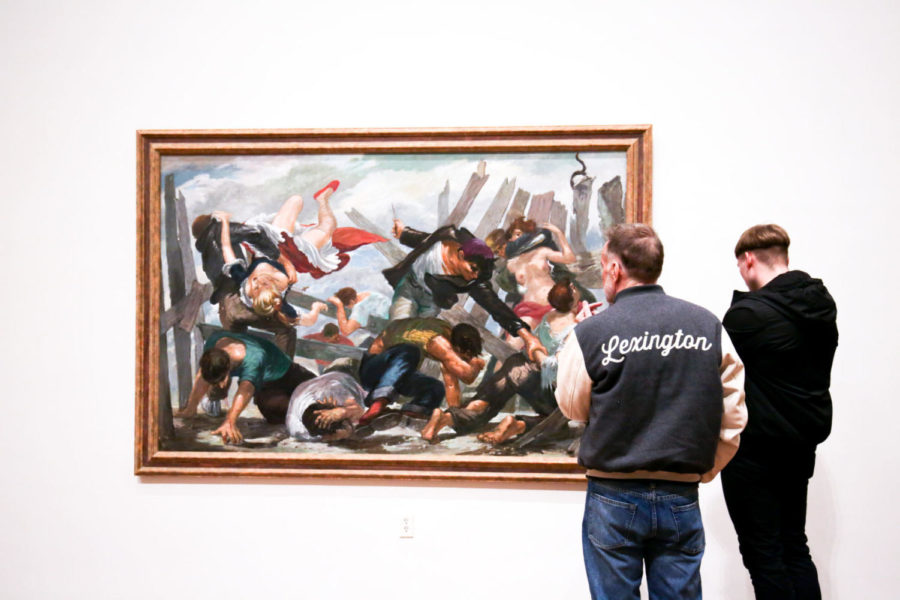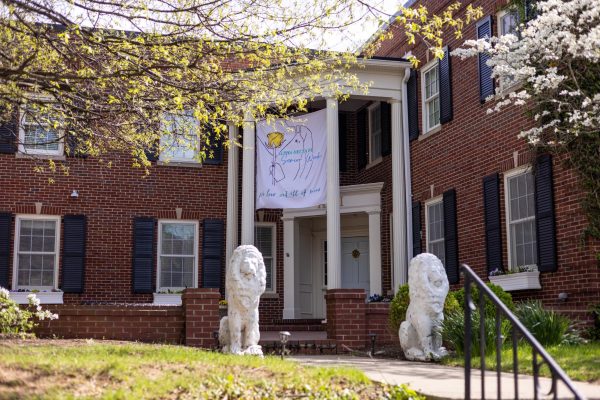FBI-blacklisted, Louisville artist makes his long-deserved debut at UK Art Museum
Lexingtonians viewed Edward Melcarth’s Rape of Sabines in the UK Art Museum on Thursday, January 18, 2018. Rape of the Sabines is part of the UK Art Museum’s exhibition EDWARD MELCARTH: Points of View which will be on display until April 8. Photo by Arden Barnes | Staff
January 19, 2018
Gay, Jewish, Communist, FBI-blacklisted and Kentucky-born.
On Thursday, Jan. 18, several hundred people came to the UK Art Museum to be introduced to Louisville artist Edward Melcarth’s work.
“I think we’re all sharing this moment where we get to discover Edward together,” said Kentucky historian Jonathan Coleman.
Melcarth, who died in 1973, used his artwork to comment on “masculinity, religion, portraiture, drug use, and the American scene” in the mid 1900s– starting difficult, controversial and appreciative discussions among his viewers, the UK Art Museum website said. In the age of Pop Art and Expressionism, Melcarth chose to create his work in the style of the “Old Masters.”
“These paintings have a lot going on,” said Guy Mendes, a professor of photography in UK’s School of Art and Visual Studies. “They’re meaty and fleshy and people are getting hurt in some and others are in dangerous situations. It’s brutal realism in a lot of ways.”
“He’s having conversations [in his work] we’re still having, especially in Kentucky,” Coleman said.
Art studio major Angus Willis says he frequents the UK Art Museum, and was inspired and intrigued by Melcarth’s use of figures, masculinity and violence in his work.
Last March, Coleman approached museum staff with the idea of doing an exhibition of Melcarth’s work, said Art Museum Director Stuart Horodner.
Coleman, who is a gender and sexuality historian at UK, and local artist Robert Morgan came across Melcarth’s work through their research and work with the Faulkner Morgan Pagan Babies Archive, which focuses on collecting photographs and documenting the history of Kentucky’s LGBTQ community.
Coleman found Melcarth’s work within the Forbes Foundation.
In his life, Melcarth was a friend and patron to Peggy Guggenheim, Gore Vidal and Tennessee Williams.
Melcarth was featured in Time magazine in 1950 as an artist to watch, has work in the Smithsonian American Art Museum and won an award from the Art Institute of Chicago in 1951.
Melcarth was well known in his lifetime, but after his death in 1973 was largely forgotten.
Janie Welker, the museum curator, said the exhibition is “really discovering an artist that was unknown and he deserves more recognition.”
The exhibition “EDWARD MELCARTH: Points of View” will be on display in the UK Art Museum until April 8.




















































































































































